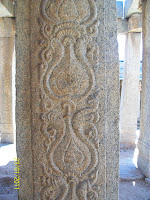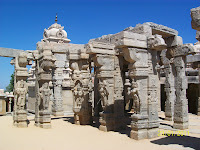Lepakshi is a 16th Century architectural splendor in the Ananthpur District of Andhra Pradesh, 15km from Hindupur and approximately 140 km from Bangalore. We headed towards Lepakshi on NH7, the Bangalore-Hyderabad highway (an awesome road we have ever driven so far!). On reaching the Karnataka-Andhra Pradesh border, we took an immediate left on crossing a check post, onto a country road and drove 10km on the bumpy country road to reach Lepakshi, surpassing the Veerapuram Village (Bird Sanctuary), where Painted Stork’s can be sighted between December and July.


Lepakshi, the storehouse of art and architecture in the Vijayanagara Style, is famous for the Veerabhadra Temple and its sculptures. The Lepakshi designs on sarees are popular amongst the women folk which are taken from here.
The huge monolithic Nandi (Bull) greeted us on our arrival at Lepakshi. The monolithic Bull/Basavanna, about 15 feet high and 27 feet in length, is a remarkable piece of work in stone. It faces the Naga Linga, where a seven headed cobra shades a Shiva Linga, which again is a monolithic piece. The priest at the temple took us around and enlightened us about the place and its significance. He said that the temple was over 500 years old and was built by Viranna and Virupana brothers, who were chieftains in the court of the Vijjayanagara King, Achutaraya. Of the three shrines dedicated to Shiva, Vishnu and Veerabhadra, the Veerabhadra temple draws all attention. We were also informed that Amarashilpi Jakkannachari played a key role in terms of the architecture of the temple.
We were presented with two interesting stories as to how the place got its name as “Lepakshi”. One of them dated back to Ramayana where the bird Jatayu died, fighting Ravana when he abducted Sita after narrating the details to Rama. At that point in time Rama says “Le Pakshi” to Jatayu (Le - meaning get up and Pakshi - meaning Bird in Telugu) and hence the name. The other version, is that Virupana wanted to build a temple for Lord Veerabhadra and made use of the treasury of the king Achutaraya, in his absence (as the king was away, waging war), without seeking permission. The king on his return found the treasury empty and ordered that Virupana should be blinded! Virupana, being a loyal subordinate of the king carried out the instructions of his master without dismay! Lepa – meaning Less and Akshi – meaning Eyes! We could see the marks on one of the walls, near the Kalyana Mantapa and were told by the priest that they were the blood stains of Virupana’s eyes!
The temple complex is divided into the outer Nithya/Mukha Mantapa, inner Artha Mantapa and the innermost Garbha Gudi, which is the sanctum sanctorum, where the idol of Lord Veerabhadra is placed. The temple complex harbors the idol of Lord Ganesha, a huge monolithic Nagalinga (where the Shivalinga is protected by a seven headed snake), the hanging pillar, the foot print of Sita Devi and numerous halls, supported by artistically carved pillars. The incomplete Kalyana Mantapa, without a roof, supported by 38 carved pillars is a major attraction and we were told that Shiva and Parvathi were married in the place where this Kalyana Mantapa stands. The walls of the temple are sculpted with the stories of Ramayana and Mahabharatha, while the ceiling is beautifully painted using natural dyes (The paintings look faded as they are not well maintained, however, the precision and the symmetry of the paintings can be highly appreciated).
With our mission accomplished at this treasure house of Art and Architectural splendor, we returned to Bangalore.























































